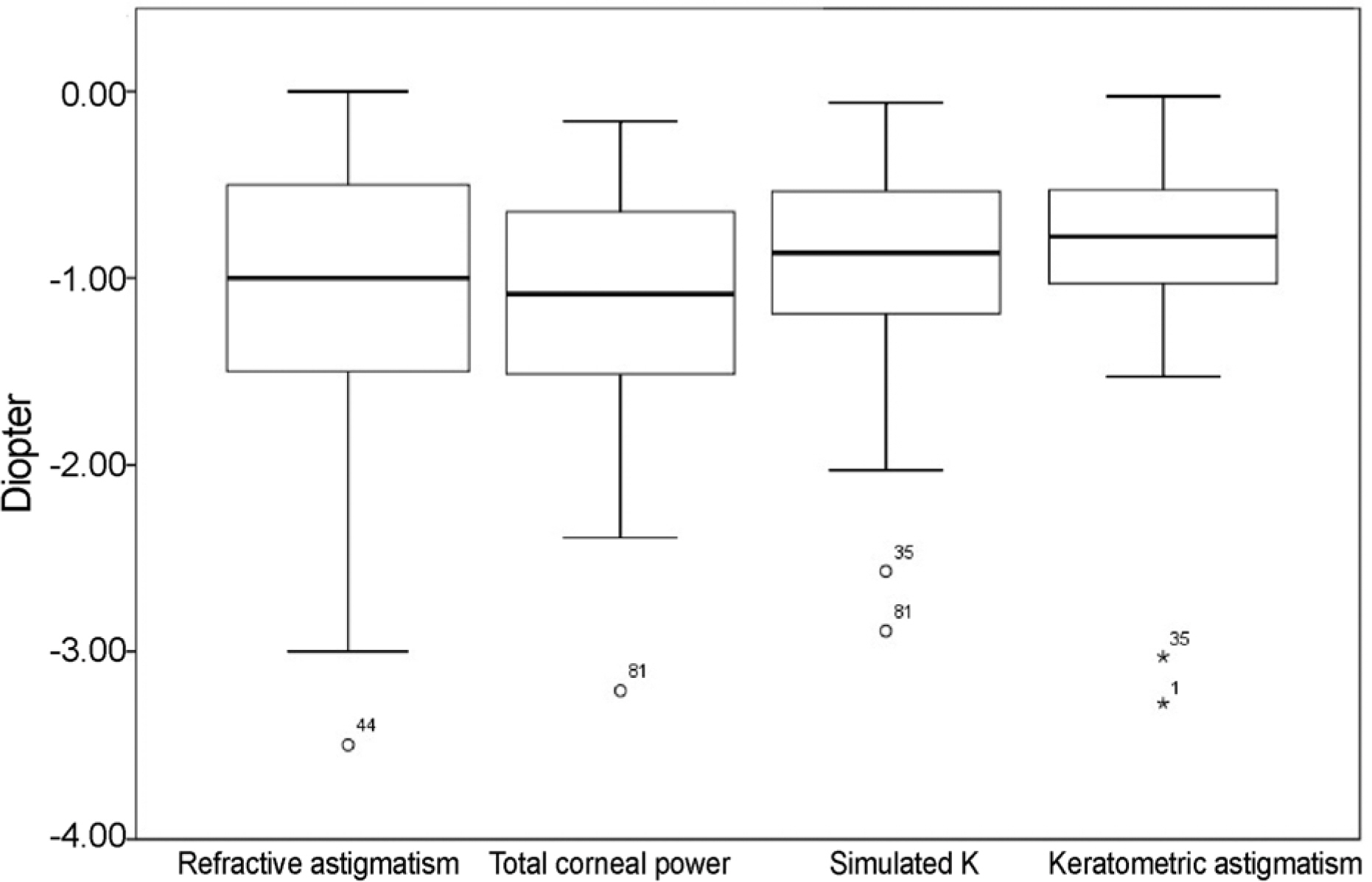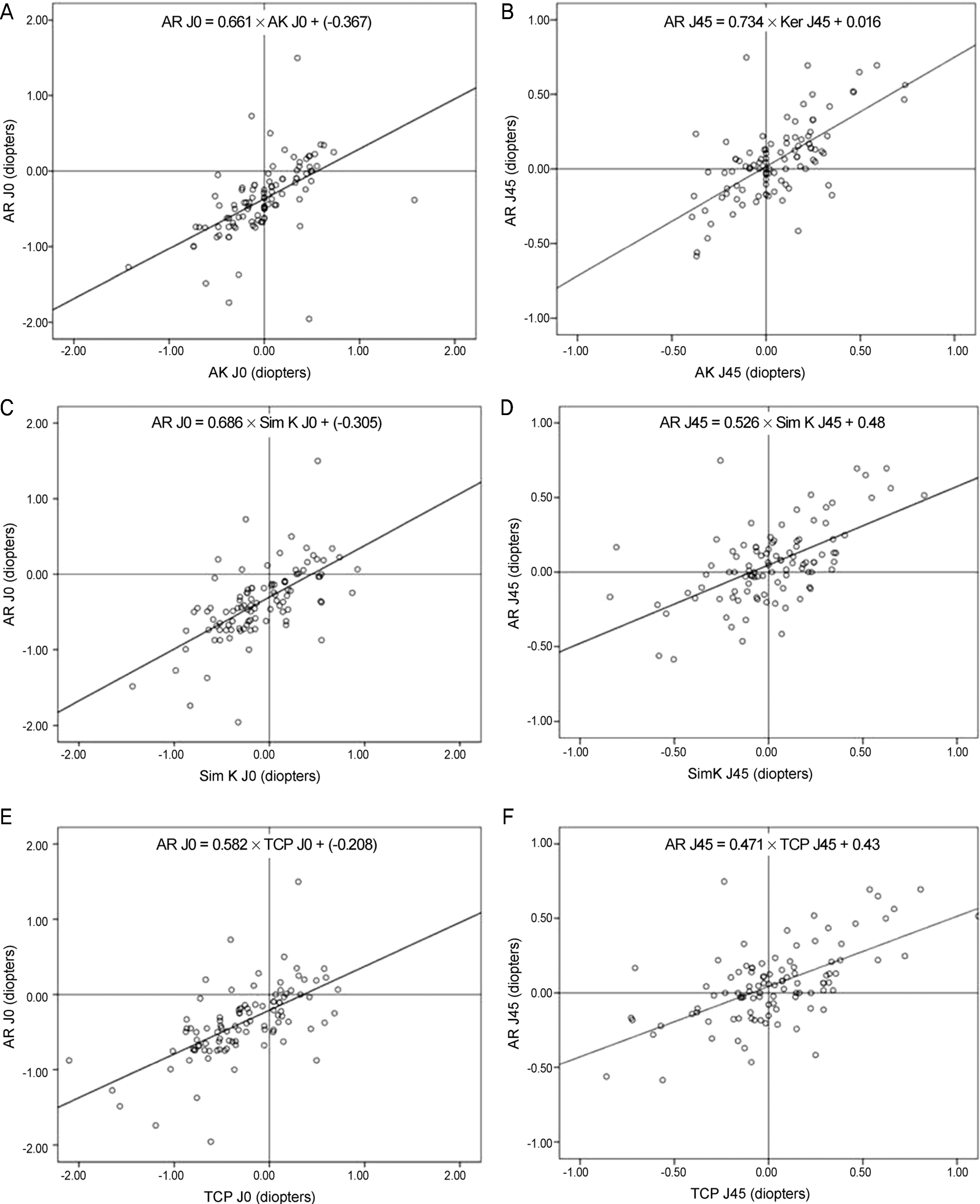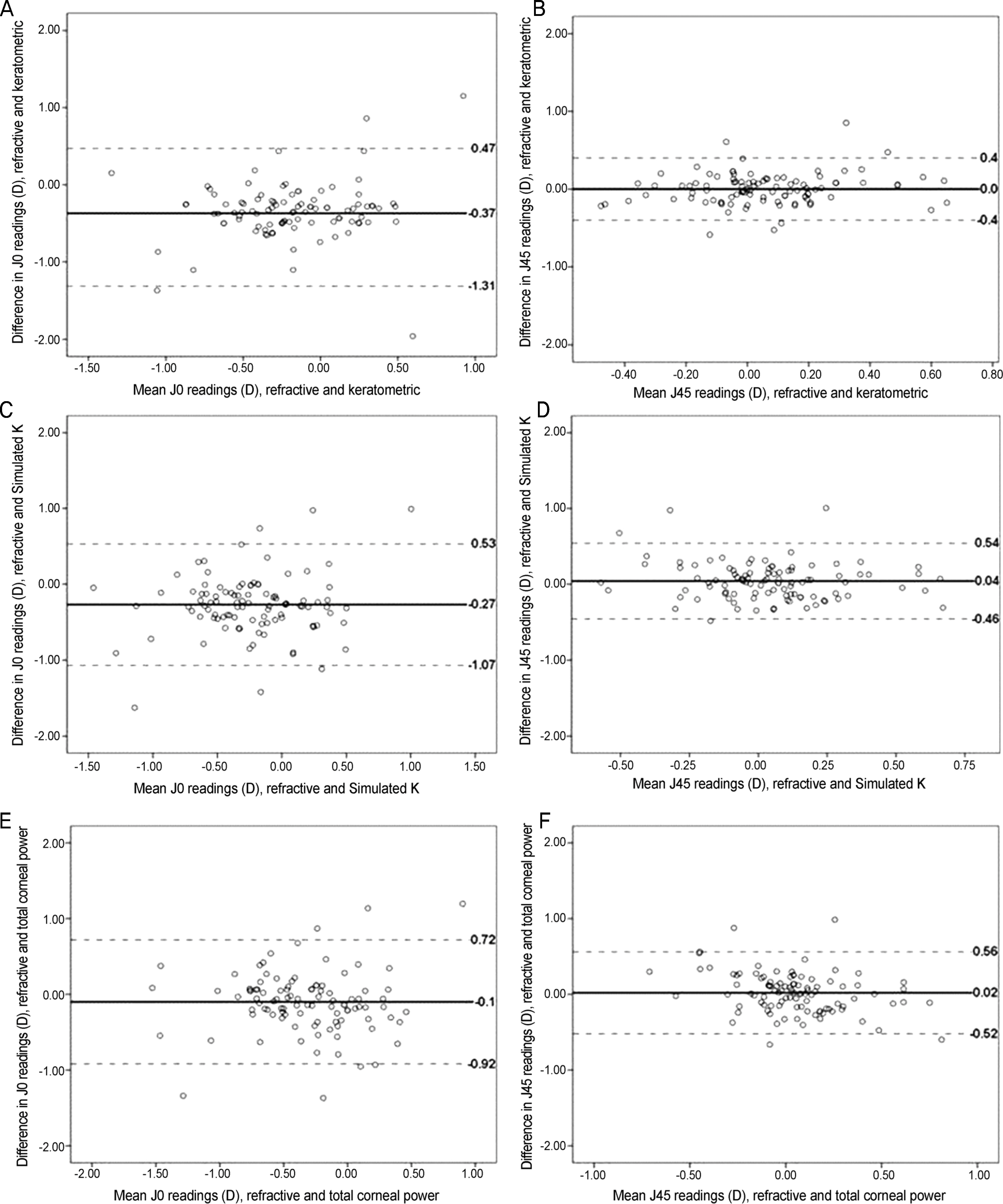J Korean Ophthalmol Soc.
2016 Mar;57(3):361-368. 10.3341/jkos.2016.57.3.361.
Astigmatic Correlation between the Automated Refractometry and Dual Scheimpflug Analyzer in Pseudophakic Eyes
- Affiliations
-
- 1Department of Ophthalmology, Hanyang University Guri Hospital, Hanyang University College of Medicine, Guri, Korea. ocularimmunity@gmail.com
- 2Department of Ophthalmology, Hanyang University Hospital, Hanyang University College of Medicine, Seoul, Korea.
- KMID: 2213236
- DOI: http://doi.org/10.3341/jkos.2016.57.3.361
Abstract
- PURPOSE
To examine the relationship between the refractive astigmatism by automated refractometry and the corneal astigmatism by a dual Scheimpflug analyzer in pseudophakic eyes.
METHODS
Prospectively, 75 patients (100 eyes) were enrolled in the present study. Refractive astigmatism was obtained by automated refraction. Corneal astigmatism was obtained using automated keratometry (ARK-530A®) and dual Scheimpflug scanning analysis (Galilei G4®). All refractive values were converted to the power vector components J0 and J45 for comparison and regression analysis of refractive versus corneal astigmatism. Bland-Altman plots were created to estimate the agreement between measurements.
RESULTS
The average astigmatism from each measurement was -1.11 ± 1.44 D (refractive astigmatism from automated refraction), -0.77 ± 1.06 D (corneal astigmatism from automated keratometry), -0.93 ± 1.02 D (simulated K from Galilei G4®), and -1.11 ± 1.48 D (total corneal power from Galilei G4®). Refractive J0 and keratometric J0 were significantly correlated (r = 0.557, p ≤ 0.001), as well as the corresponding J45 values (r = 0.655, p = 0.025). Refractive astigmatism and total corneal power components were also significantly correlated (J0: r = 0.618, p ≤ 0.001; J45: r = 0.608, p = 0.04). In the Bland-Altman plots, keratometric J0 and total corneal power J0 showed the best agreement.
CONCLUSIONS
The accuracy of measurements for corneal refraction and astigmatism in pseudophakic eyes is higher using the dual Scheimpflug analyzer, especially for total corneal power. This value of astigmatism can take into account the refractive astigmatism of pseudophakic eyes and can be used in evaluating postoperative corneal astigmatism.
Keyword
Figure
Reference
-
References
1. Ho JD, Liou SW, Tsai RJ, Tsai CY. Effects of aging on anterior and posterior corneal astigmatism. Cornea. 2010; 29:632–7.
Article2. Teus MA, Arruabarrena C, Hernández-Verdejo JL, et al. Correlation between keratometric and refractive astigmatism in pseudophakic eyes. J Cataract Refract Surg. 2010; 36:1671–5.
Article3. Shirayama M, Wang L, Koch DD, Weikert MP. Comparison of accuracy of intraocular lens calculations using automated keratometry, a Placido-based corneal topographer, and a combined Placido-based and dual Scheimpflug corneal topographer. Cornea. 2010; 29:1136–8.4. Butcher JM, O'Brien C. The reproducibility of biometry and keratometry measurements. Eye (Lond). 1991; 5(Pt 6):708–11.
Article5. Han JM, Choi HJ, Kim MK, et al. Comparative analysis of corneal refraction and astigmatism measured with Autokeratometer, IOL master, and topography. J Korean Ophthalmol Soc. 2011; 52:1427–33.
Article6. Shirayama M, Wang L, Weikert MP, Koch DD. Comparison of corneal powers obtained from 4 different devices. Am J Ophthalmol. 2009; 148:528–35.e1.
Article7. Menassa N, Kaufmann C, Goggin M, et al. Comparison and reproducibility of corneal thickness and curvature readings obtained by the Galilei and the Orbscan II analysis systems. J Cataract Refract Surg. 2008; 34:1742–7.
Article8. Thibos LN, Horner D. Power vector analysis of the optical outcome of refractive surgery. J Cataract Refract Surg. 2001; 27:80–5.
Article9. Thibos LN, Wheeler W, Horner D. Power vectors: an application of Fourier analysis to the description and statistical analysis of refractive error. Optom Vis Sci. 1997; 74:367–75.
Article10. Findl O, Drexler W, Menapace R, et al. High precision biometry of pseudophakic eyes using partial coherence interferometry. J Cataract Refract Surg. 1998; 24:1087–93.
Article11. Koch DD, Ali SF, Weikert MP, et al. Contribution of posterior corneal astigmatism to total corneal astigmatism. J Cataract Refract Surg. 2012; 38:2080–7.
Article12. Axt JC, McCaffery JM. Reduction of postoperative against-the-rule astigmatism by lateral incision technique. J Cataract Refract Surg. 1993; 19:380–6.
Article13. Kohnen S, Neuber R, Kohnen T. Effect of temporal and nasal unsutured limbal tunnel incisions on induced astigmatism after phacoemulsification. J Cataract Refract Surg. 2002; 28:821–5.
Article14. Masket S, Wang L, Belani S. Induced astigmatism with 2.2- and 3.0-mm coaxial phacoemulsification incisions. J Refract Surg. 2009; 25:21–4.
Article15. Tejedor J, Guirao A. Agreement between refractive and corneal astigmatism in pseudophakic eyes. Cornea. 2013; 32:783–90.
Article
- Full Text Links
- Actions
-
Cited
- CITED
-
- Close
- Share
- Similar articles
-
- Comparison of Anterior Segment Parameters Obtained by Anterior Segment Optical Coherence Tomography and Dual Rotating Scheimpflug Camera
- Central Corneal Thickness Measured by Noncontact Specular Microscopy, Dual Rotating Scheimpflug Camera and Ultrasound Pachymetry
- Corneal Thickness Measured by Dual Scheimpflug, Anterior Segment Optical Coherence Tomography, and Ultrasound Pachymetry
- A Comparison of Central Corneal Thickness Measurements and Measurement Repeatability Using Three Imaging Modalities
- Internal Lens Signal Measured by Dual Scheimpflug Anterior Segment Analyzer





